
Practice Series
Errata Compilation
P3 & P4 Topics
Animal Classification Practice Booklet – Errata
No errata found at this point! 🙂
Animal Cycles Practice Booklet – Errata
No errata found at this point! 🙂
Living & Non-living Things Practice Booklet – Errata
No errata found at this point! 🙂
Plants, Fungi & Bacteria Practice Booklet – Errata
No errata found at this point! 🙂
Matter Practice Booklet – Errata
No errata found at this point! 🙂
P5 & P6 Topics
Cells Practice Booklet – Errata
OEQ Question Booklet Update
![]() Q17 (Question Booklet – Page 12, OEQ): HMPS/2013/P6/SA1/Q31
Q17 (Question Booklet – Page 12, OEQ): HMPS/2013/P6/SA1/Q31
Cell X should not have chloroplasts (too many black spots).One of Cell Y has an extra nucleus.
Please use this amended diagram:

![]() Q24 (Question Booklet – Page 41, OEQ): NYPS/2017/P5/SA2/Q30
Q24 (Question Booklet – Page 41, OEQ): NYPS/2017/P5/SA2/Q30
Voided question: Part (a) was voided by the school. It is now voided accordingly in this question booklet.
OEQ Answer Booklet Update
![]() Q25a (Question Booklet – Page 2, OEQ): SNGS/2017/P6/SA1/Q29
Q25a (Question Booklet – Page 2, OEQ): SNGS/2017/P6/SA1/Q29
Explain data: to control all activities in the cell, such as cell division and does not contain genetic information to be passed down from one generation to the next generation. Thus, cell D cannot reproduce. (Change The Explain Data Part)
Body Systems Practice Booklet – Errata
MCQ Question Booklet Update
![]() Q5 (Question Booklet – Page 26, MCQ): PHPPS/2017/P6/SA2/Q9
Q5 (Question Booklet – Page 26, MCQ): PHPPS/2017/P6/SA2/Q9
The label on the diagram should read ‘folded inner layer’.
OEQ Answer Booklet Update
![]() Q22 (Question Booklet – Page 39, OEQ): PHPPS/2017/P6/SA2/Q33
Q22 (Question Booklet – Page 39, OEQ): PHPPS/2017/P6/SA2/Q33
Answer Update Q22a: The large intestine is responsible for absorbing excess water and mineral salts from undigested food before the undigested food is passed out of the body as stools. As the large intestine absorbed too little water from the undigested food, Jenny had watery stools.
Answer Update Q22b: The watery stools mean that Jenny’s body is absorbing less water into the bloodstream. Thus, she should drink more water so that her body has sufficient water, which is important for carrying out life processes.
![]() Q24b (Question Booklet – Page 41, OEQ): NYPS/2017/P5/SA2/Q30
Q24b (Question Booklet – Page 41, OEQ): NYPS/2017/P5/SA2/Q30
Answer Update: A smoker has less air sacs in the lungs for exchange of gases. Thus, the smoker has to breathe faster to take in more oxygen to allow for sufficient oxygen to be absorbed into the bloodstream. The oxygen is then transported through the bloodstream to all parts of the body and is used by the body cells for respiration to release sufficient energy.
![]() Q25 (Question Booklet – Page 42-43, OEQ): ACSJ/2016/P5/CA1/Q22
Q25 (Question Booklet – Page 42-43, OEQ): ACSJ/2016/P5/CA1/Q22
Answer Update Q25b: The blood in blood vessel A contains more carbon dioxide than the blood in blood vessel C.
Answer Update Q25c: Choose: Blood sample S. Use data: The amount of oxygen in blood sample S was the least. Explain data: The blood carried in the blood vessel from the heart to the lungs has passed through the heart twice and the other parts of the body once. Hence, most amount of oxygen in the blood would have been used by the cells for respiration to release energy. This results in the least amount of oxygen in the blood.
Errata Affecting Copies Before 31 Dec 2019
MCQ Question Booklet Update
![]() Q20 (Question Booklet – Page 37, MCQ): CHS/2017/P6/SA1/Q9
Q20 (Question Booklet – Page 37, MCQ): CHS/2017/P6/SA1/Q9
Question Update: The part that is circled should be Substance M instead of Substance N.

OEQ Question Booklet Update
![]() Q24c (Question Booklet – Page 41, OEQ): NYPS/2017/P5/SA2/Q30c
Q24c (Question Booklet – Page 41, OEQ): NYPS/2017/P5/SA2/Q30c
Question Update: The question for part (c) has been omitted. Here’s the question:
When both the smoker and non-smoker exercise, their breathing rates will increase. Explain why. [2]
Answer Booklet Update
![]() Q26b (Answer Booklet – Page 5, OEQ): ROSYTH/2017/P5/SA2/Q33
Q26b (Answer Booklet – Page 5, OEQ): ROSYTH/2017/P5/SA2/Q33
Answer Update: Remove this line to avoid confusion: Minus half mark each for any missing part.
Heat Energy Practice Booklet – Errata
MCQ Question Booklet Update
![]() Q20 (Question Booklet – Page 17, MCQ): SCGS/2017/P5/SA1/Q28
Q20 (Question Booklet – Page 17, MCQ): SCGS/2017/P5/SA1/Q28
Diagram Update: Curvature on the steel cable was adjusted for clarity on the question.

Typographical error on the question. Please refer to amended question: Which of the following correctly shows how the cables would appear on days when their temperatures are 5 °C and 38 °C respectively?
Errata Affecting Copies Before 31 Dec 2019
MCQ Question Booklet Update
![]() Q32 (Question Booklet – Page 29, MCQ): CHS/2017/P6/SA2/Q22
Q32 (Question Booklet – Page 29, MCQ): CHS/2017/P6/SA2/Q22
Question Update: If your copy’s question number on Page 29 reads Q22, please correct it to Q32.
OEQ Question Booklet Update
![]() Q2 (Question Booklet – Page 2, OEQ): MBS/2012/P6/SA2/Q43
Q2 (Question Booklet – Page 2, OEQ): MBS/2012/P6/SA2/Q43
Question Update: There may be a typo in Q2(a):
Explain why the pieces of paper in Set-up X did not burn. [1]
Water Cycle Practice Booklet – Errata
MCQ Question Booklet Update
![]() Q19 (Question Booklet – Page 14, MCQ): NYPS/2016/P6/SA1/Q12
Q19 (Question Booklet – Page 14, MCQ): NYPS/2016/P6/SA1/Q12
Corrected: He managed to collect 50 ml of pure water in 1 hour.
![]() Q23 (Question Booklet – Page 18, MCQ): SNGS/2014/P6/SA2/Q29
Q23 (Question Booklet – Page 18, MCQ): SNGS/2014/P6/SA2/Q29
Please refer to amended diagram:

Errata Affecting Copies Before 31 Dec 2019
MCQ Question Booklet Update
![]() Q34 (Question Booklet): RSS/2015/P5/SA2/Q22
Q34 (Question Booklet): RSS/2015/P5/SA2/Q22
If the above question exists in your copy, please remove it.
Light Practice Booklet – Errata
MCQ Question Booklet Update
![]() Q6 (Question Booklet – Page 6, MCQ): MGS/2012/P6/SA1/Q26
Q6 (Question Booklet – Page 6, MCQ): MGS/2012/P6/SA1/Q26
Diagram error: The shadowed areas of every page should vary in darkness. Please refer to amended diagram:

![]() Q18 (Question Booklet – Page 18, MCQ): RGPS/2015/P6/SA1/Q26
Q18 (Question Booklet – Page 18, MCQ): RGPS/2015/P6/SA1/Q26
Question has been adapted for clarity: All mentions of ‘plastic’ are specified to be clear plastic’.
![]() Q21 (Question Booklet – Page 21, MCQ): SNGS/2012/P6/SA1/Q28
Q21 (Question Booklet – Page 21, MCQ): SNGS/2012/P6/SA1/Q28
Diagram Error: Please take note of the following change:

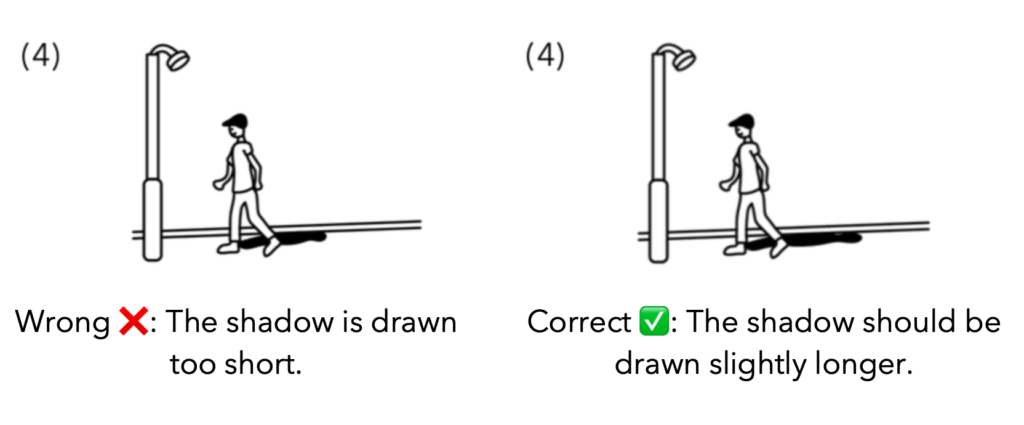
![]() Q35 (Question Booklet – Page 35, MCQ): NYPS/2017/P6/SA1/Q25
Q35 (Question Booklet – Page 35, MCQ): NYPS/2017/P6/SA1/Q25
Diagram error: Diagram erroneously included an outline of a circle in the back. Please refer to amended diagram:

OEQ Answer Booklet Update
![]() Q1b (Answer Booklet – Page 1, OEQ): RSS/2013/P5/SA1/Q43
Q1b (Answer Booklet – Page 1, OEQ): RSS/2013/P5/SA1/Q43
Answer Update: … further away from the torch.
![]() Q12a (Answer Booklet – Page 4, OEQ): NYPS/2015/P6/SA1/Q43
Q12a (Answer Booklet – Page 4, OEQ): NYPS/2015/P6/SA1/Q43
Spelling Error: Changed well-light to well-lit.
![]() Q12c (Answer Booklet – Page 4, OEQ): NYPS/2015/P6/SA1/Q43
Q12c (Answer Booklet – Page 4, OEQ): NYPS/2015/P6/SA1/Q43
Answer Update: The piece of cardboard is opaque and does not allow light to pass through. Thus, light from the light source that is reflected off the wrist watch cannot travel into Matthew’s eyes, preventing him from seeing the wrist watch.
![]() Q15b (Answer Booklet – Page 5, OEQ): CHS/2017/P5/SA2/Q38
Q15b (Answer Booklet – Page 5, OEQ): CHS/2017/P5/SA2/Q38
Answer Update: Use data: When the distance between the light source and material R increases, the reading on the light sensor is the highest.
![]() Q18a (Answer Booklet – Page 5, OEQ): TNS/2016/P5/SA2/Q29
Q18a (Answer Booklet – Page 5, OEQ): TNS/2016/P5/SA2/Q29
Spelling Error: Changed geatest to greatest.
Errata Affecting Copies Before 31 Dec 2019
Answer Booklet Update
![]() Q9 (Answer Booklet – Page 1, MCQ): BVPS/2014/P6/SA1/Q21
Q9 (Answer Booklet – Page 1, MCQ): BVPS/2014/P6/SA1/Q21
Answer Update: The answer is (1).
Magnets Practice Booklet – Errata
MCQ Question Booklet Update
![]() Q14 (Question Booklet – Page 14, MCQ): SNGS/2016/P6/SA2/Q27
Q14 (Question Booklet – Page 14, MCQ): SNGS/2016/P6/SA2/Q27
Diagram Error: Please take note of the following change: The springs have been redrawn across all diagrams to reflect compression and expansion.
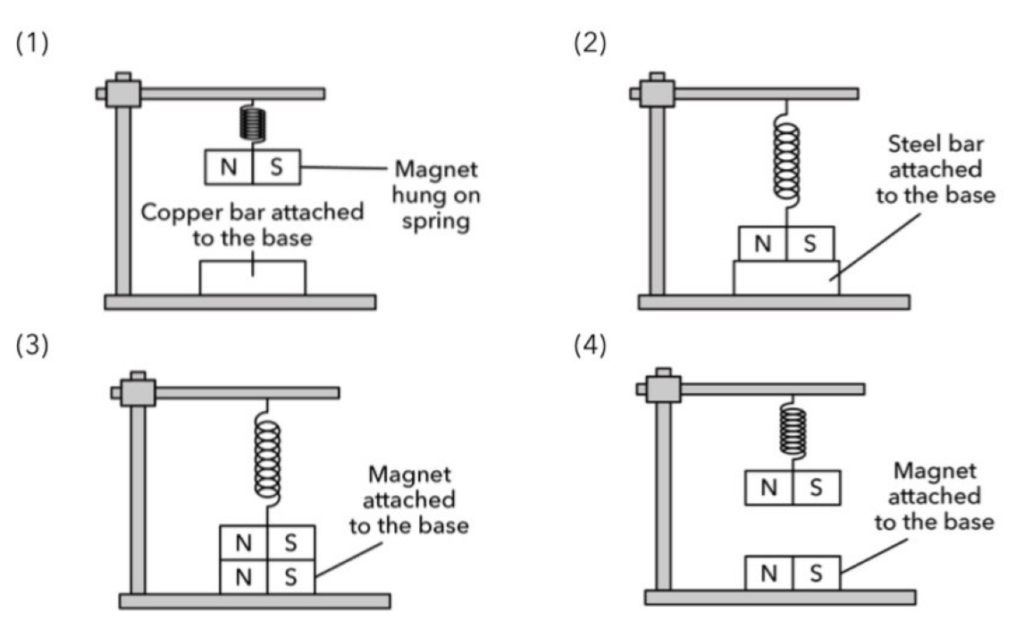
![]() Q48 (Question Booklet – Page 47, MCQ): SHPS/2017/P6/SA2/Q24
Q48 (Question Booklet – Page 47, MCQ): SHPS/2017/P6/SA2/Q24
Diagram Error: Diagram was missing a point X. Please take note of the amended diagram:

OEQ Question Booklet Update
![]() Q16c (Question Booklet – Page 20, OEQ): RSS/2013/P5/SA1/Q41
Q16c (Question Booklet – Page 20, OEQ): RSS/2013/P5/SA1/Q41
Diagram Error: Steel weight was not connected to the device. Please take note of the amended diagram:
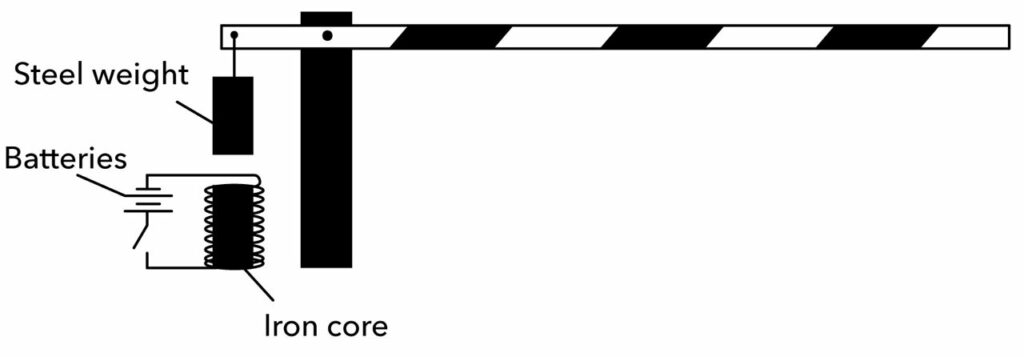
OEQ Answer Booklet Update
![]() Q7b (Question Booklet – Page 8, OEQ): MGS/2016/P6/SA2/Q38
Q7b (Question Booklet – Page 8, OEQ): MGS/2016/P6/SA2/Q38
P6 Answer (Updated): As material Y moved over the roller with magnets, the magnetic force of attraction acting on material Y was greater than the gravitational force acting on material Y, preventing it from falling into container P. However, as material Y moves further away from the roller with magnets, the magnetic force of attraction acting on material Y was smaller than the gravitational force acting on material Y, causing it to fall into container Q.
![]() Q10b (Question Booklet – Page 11, OEQ): RSS/2017/P6/SA1/Q39
Q10b (Question Booklet – Page 11, OEQ): RSS/2017/P6/SA1/Q39
Amended Answer: The like poles of magnets Y and X are facing each other, causing them to repel, pushing magnet X up to balance the scale with the lighter object Q.
![]() Q11b (Question Booklet – Page 14, OEQ): SCGS/2013/P5/SA2/Q36
Q11b (Question Booklet – Page 14, OEQ): SCGS/2013/P5/SA2/Q36
Answer Update: There would not be any copper nails moving towards the iron sheet. The iron sheet is made of a magnetic material and does not allow the magnet’s magnetism to pass through it. The copper nails are made of a non-magnetic material and will not be attracted by the magnet.
![]() Q12a (Question Booklet – Page 15, OEQ): HPPS/2015/P6/SA1/Q44
Q12a (Question Booklet – Page 15, OEQ): HPPS/2015/P6/SA1/Q44
Add on for P6 students (Updated): The magnetic force of attraction acting on the metal clip was greater than the gravitational force acting on the metal clip, preventing it from dropping.
![]() Q16b (Question Booklet – Page 20, OEQ): RSS/2013/P5/SA1/Q41
Q16b (Question Booklet – Page 20, OEQ): RSS/2013/P5/SA1/Q41
Updated Answer: When the power supply was cut off, no electric current flowed through the wires, causing the rods to lose their magnetism. Thus, the rods were no longer able to attract the nails, causing them to drop back into the container.
![]() Q16c (Question Booklet – Page 20, OEQ): RSS/2013/P5/SA1/Q41
Q16c (Question Booklet – Page 20, OEQ): RSS/2013/P5/SA1/Q41
Amended answer: When the security guard switches on the power supply, there is a closed circuit with the coils of wire. Thus, electric current flows through the coils of wire, causing the iron core to be magnetised to become an electromagnet.
The electromagnet’s magnetism acts at a distance to attract the steel weight, which is made of a magnetic material. This exerts a pull force on the steel weight, causing it to move downwards and raise the barrier.
![]() Q16d (Question Booklet – Page 20, OEQ): RSS/2013/P5/SA1/Q41
Q16d (Question Booklet – Page 20, OEQ): RSS/2013/P5/SA1/Q41
Amended answer: Increase the number of batteries in the circuit. OR Increase the number of coils of wire around the iron core.
![]() Q17 (Question Booklet – Page 21, OEQ): RSS/2014/P6/SA1/Q40
Q17 (Question Booklet – Page 21, OEQ): RSS/2014/P6/SA1/Q40
Amended answer: When switch B is closed, … coils of wire. Electric current passes through the coils of wire, causing the iron rod to be magnetised to become an electromagnet. The electromagnet’s magnetism acts at a distance to attract steel contact Z, which is made of magnetic material. This causes steel contacts X and Y to lose contact with Z, creating an open circuit in circuit A, even with switch A closed. Thus, no electric current flows through the fan, preventing it from working.
![]() Q18b (Question Booklet – Page 22, OEQ): SNGS/2015/P6/CA1/Q40
Q18b (Question Booklet – Page 22, OEQ): SNGS/2015/P6/CA1/Q40
Amended answer: When electric current passed through the coil, the iron core was magnetised to become an electromagnet. The electromagnet’s magnetism acted at a distance to attract the iron disc, which is made of a magnetic material. This exerts a pull force on the spring balance, causing its reading to increase.
![]() Q19a (Question Booklet – Page 23, OEQ): RGPS/2016/P6/SA1/Q39
Q19a (Question Booklet – Page 23, OEQ): RGPS/2016/P6/SA1/Q39
Amended answer: Siti’s results. The magnetism of the horseshoe magnet is the strongest at its poles, which are parts A and E. Thus, parts A and E of the horseshoe magnet should attract the most number of iron nails, which is shown in Siti’s results.
![]() Q20a (Question Booklet – Page 25, OEQ): TNS/2017/P5/SA2/Q38
Q20a (Question Booklet – Page 25, OEQ): TNS/2017/P5/SA2/Q38
Amended answer: When the switch is closed, there is a closed circuit with the coils of wire. Thus, electric current flows through the coils of wire, causing the iron bar to be magnetised to become an electromagnet.
![]() Q22a (Question Booklet – Page 27, OEQ): SHHG/2013/P6/SA2/Q40
Q22a (Question Booklet – Page 27, OEQ): SHHG/2013/P6/SA2/Q40
Add on for P6 students (Updated): The magnetic force of repulsion between the magnets is greater than the gravitational force acting on magnet X, causing magnet X to float above magnet Y.
![]() Q23a (Question Booklet – Page 28, OEQ): MGS/2015/P5/SA1/Q39
Q23a (Question Booklet – Page 28, OEQ): MGS/2015/P5/SA1/Q39
Add on for P6 students (Updated): The magnetic force of attraction acting on the metal clip was greater than the gravitational force acting on the metal clip, causing it to remain in the air.
![]() Q20a (Question Booklet Page 25, OEQ): TNS/2017/P5/SA2/Q38
Q20a (Question Booklet Page 25, OEQ): TNS/2017/P5/SA2/Q38
Amended answer: When the switch is closed, there is a closed circuit with the coils of wire. Thus, electric current flows through the coils of wire, causing the iron bar to be magnetised to become an electromagnet. The electromagnet’s magnetism acts at a distance to attract the iron nails, which are made of a magnetic material, causing the iron nails to move towards the iron bar.
Errata Affecting Copies Before 31 Dec 2019
MCQ Question Booklet Update
![]() Q2 (Question Booklet – Page 2, MCQ): ACSJ/2016/P5/SA1/Q10
Q2 (Question Booklet – Page 2, MCQ): ACSJ/2016/P5/SA1/Q10
Question Update: If the question in your copy is missing under the diagram, please add this in:
Which one of the following arrangements of magnets is not possible?
![]() Q56 (Question Booklet – Page 55, MCQ): RMPS/2012/P5/SA1/Q16
Q56 (Question Booklet – Page 55, MCQ): RMPS/2012/P5/SA1/Q16
Question Update: There has been an error in the diagram. Check if the darker coloured bar for Magnet Q exists in your copy.

Answer Booklet Update
![]() Q12 (Answer Booklet – Page 1, MCQ): ACSJ/2013/P5/SA2/Q9
Q12 (Answer Booklet – Page 1, MCQ): ACSJ/2013/P5/SA2/Q9
Answer Update: The answer is (3).
![]() Q27 (Answer Booklet – Page 1, MCQ): SCGS/2013/P6/SA2/Q11
Q27 (Answer Booklet – Page 1, MCQ): SCGS/2013/P6/SA2/Q11
Answer Update: The answer is (3) W and X only.
![]() Q29 (Answer Booklet – Page 1, MCQ): CHS/2015/P6/SA1/Q18
Q29 (Answer Booklet – Page 1, MCQ): CHS/2015/P6/SA1/Q18
Answer Update: The answer is (1) A only.
![]() Q11b (Answer Booklet – Page 4, OEQ): SCGS/2013/P5/SA2/Q36
Q11b (Answer Booklet – Page 4, OEQ): SCGS/2013/P5/SA2/Q36
Answer Update: There would not be any copper nails moving towards the plastic sheet. The iron sheet is made of a magnetic material and does not allow the magnet’s magnetism to pass through it. The copper nails are made of a non-magnetic material and will not be attracted by the magnet.
Plant Cycle Practice Booklet – Errata
MCQ Question Booklet Update
![]() Q47 (Question Booklet – Page 43, MCQ): ROSYTH/2014/P6/SA1/Q6
Q47 (Question Booklet – Page 43, MCQ): ROSYTH/2014/P6/SA1/Q6
Corrected: Which one of the following graphs correctly shows the relationship between the mass of the seed leaves and the height of the seedling?
![]() Q49 (Question Booklet – Page 45, MCQ): RSS/2015/P6/SA2/Q13
Q49 (Question Booklet – Page 45, MCQ): RSS/2015/P6/SA2/Q13
Corrected: Based on his results, which day will the process of photosynthesis likely to start taking place in the seedling?
![]() Q74 (Question Booklet – Page 67, MCQ): PCPS/2013/P6/SA2/Q24
Q74 (Question Booklet – Page 67, MCQ): PCPS/2013/P6/SA2/Q24
Corrected Table: [W] The hard pod splits and the seeds are light with wing-like structures.
OEQ Question Booklet Update
![]() Q16 (Question Booklet – Page 18, OEQ): SNGS/2016/P5/SA2/Q32
Q16 (Question Booklet – Page 18, OEQ): SNGS/2016/P5/SA2/Q32
Diagram Error: The ‘water-carrying tubes’ label was pointing to the wrong part. Please take note of the amended diagram:

OEQ Answer Booklet Update
![]() Q22aii (Question Booklet – Page 26, OEQ): NYPS/2015/P5/SA2/Q33
Q22aii (Question Booklet – Page 26, OEQ): NYPS/2015/P5/SA2/Q33
Corrected: When the trees are too near to one another, there will be overcrowding and they will compete with each other for water, mineral salts, space and sunlight, causing the trees to grow less healthily and produce less fruits.
![]() Q24b (Question Booklet – Page 29, OEQ): PHPPS/2016/P5/CA1/Q39/strong>
Q24b (Question Booklet – Page 29, OEQ): PHPPS/2016/P5/CA1/Q39/strong>
Corrected: Fruit needs to disperse their seeds to prevent overcrowding and reduce competition between the parent plant and the seedlings for water, mineral salts, space and sunlight to ensure healthier growth of the plants.
Errata Affecting Copies Before 31 Dec 2019
MCQ Question Booklet Update
![]() Q21 (Question Booklet – Page 18, MCQ): CBS/2014/P6/SA2/Q15
Q21 (Question Booklet – Page 18, MCQ): CBS/2014/P6/SA2/Q15
Question Update: As part of the question, “Which of the following conclusions can be made from the test?”
W: Starch is present only in the green part of the leaf.
X: Starch (Previously there’s a typo that says Start) is present in both green and white parts of the leaf.
Y: Starch is present in all parts after the leaf is exposed to sunlight.
![]() Q27 (Question Booklet – Page 24, MCQ): CHS/2013/P6/SA2/Q5
Q27 (Question Booklet – Page 24, MCQ): CHS/2013/P6/SA2/Q5
Question Update: The diagram had a missing ‘T’ in the label. Please refer to the following diagram below:

![]() Q28 (Question Booklet – Page 25, MCQ): YMPS/2014/P6/SA2/Q4
Q28 (Question Booklet – Page 25, MCQ): YMPS/2014/P6/SA2/Q4
Question Update: Take note of the direction of arrows. It should look like the diagram below:

![]() Q68 (Question Booklet – Page 61, MCQ): TNPS/2016/P5/SA2/Q3
Q68 (Question Booklet – Page 61, MCQ): TNPS/2016/P5/SA2/Q3
Question Update: The highlighted portions should be dotted arrows instead of solid arrows.
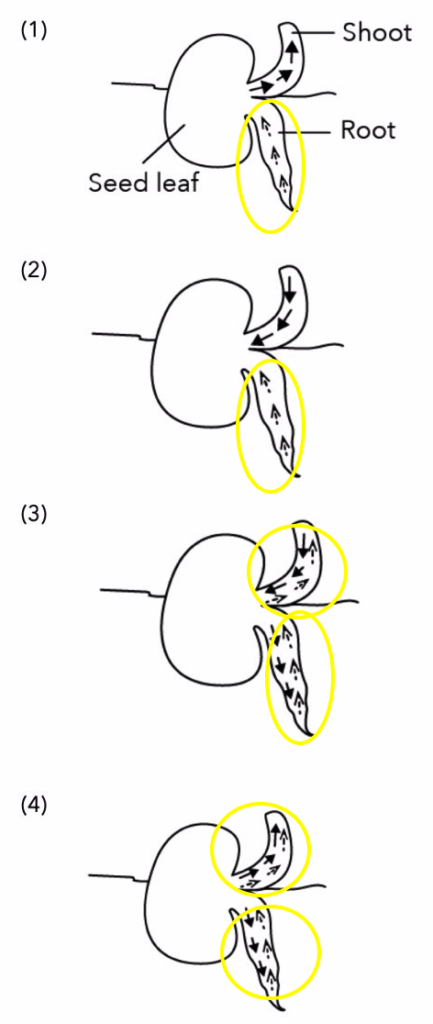
OEQ Question Booklet Update
![]() Q22 (Question Booklet – Page 26, OEQ): NYPS/2015/P5/SA2/Q33
Q22 (Question Booklet – Page 26, OEQ): NYPS/2015/P5/SA2/Q33
Question Update: The two question parts on Pg 26 should be (a)(i) and (a)(ii).
Reproduction Practice Booklet – Errata
MCQ Question Booklet Update
![]() Q1 (Question Booklet – Page 1, MCQ): FTPS/2012/P6/SA2/Q9
Q1 (Question Booklet – Page 1, MCQ): FTPS/2012/P6/SA2/Q9
Diagram Error: Label Q is pointing at the wrong part. Please take note of this amended diagram:
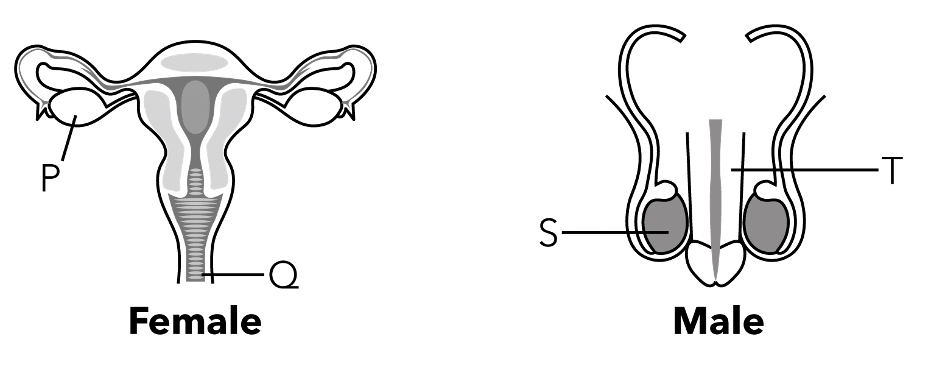
![]() Q3 (Question Booklet – Page 2, MCQ): NHPS/2013/P6/SA2/Q6
Q3 (Question Booklet – Page 2, MCQ): NHPS/2013/P6/SA2/Q6
Diagram Error: Label Q is pointing at the wrong part. Please take note of this amended diagram:

![]() Q19 (Question Booklet – Page 14, MCQ): SCGS/2014/P6/SA2/Q5
Q19 (Question Booklet – Page 14, MCQ): SCGS/2014/P6/SA2/Q5
Typographical Error: The question code itself is wrong, it should be OLN/2014/P6/SA2/Q5
![]() Q20 (Question Booklet – Page 15, MCQ): SCGS/2017/P6/SA1/Q20
Q20 (Question Booklet – Page 15, MCQ): SCGS/2017/P6/SA1/Q20
Corrected: Kumar: The foetus will not be able to develop in the womb.
![]() Q37 (Question Booklet – Page 29, MCQ): EPS/2014/P5/SA1/Q2
Q37 (Question Booklet – Page 29, MCQ): EPS/2014/P5/SA1/Q2
Typographical Error: Option 2 should read “releases a male reproductive cell”.
![]() Q53 (Question Booklet – Page 44, MCQ): CHS/2017/P5/SA1/Q7
Q53 (Question Booklet – Page 44, MCQ): CHS/2017/P5/SA1/Q7
Diagram Error: Original diagram was missing ovaries. Please take note of this amended diagram:
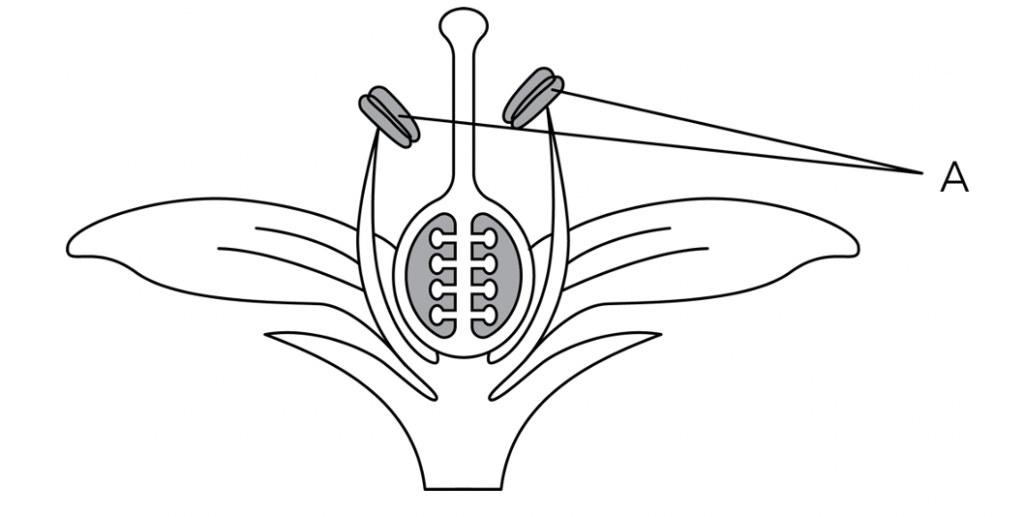
Corrected Question: B: Fertilisation will not take place.
![]() Q68 (Question Booklet – Page 54, MCQ): NHPS/2017/P5/SA2/Q10
Q68 (Question Booklet – Page 54, MCQ): NHPS/2017/P5/SA2/Q10
Corrected Question: The diagram can be used for both the human and the plant reproductive systems.
![]() Q70 (Question Booklet – Page 55, MCQ): ROSYTH/2017/P6/SA2/Q5
Q70 (Question Booklet – Page 55, MCQ): ROSYTH/2017/P6/SA2/Q5
Corrected Question: The diagrams below show the reproductive systems in a plant and human respectively.
OEQ Question Booklet Update
![]() Q2c (Question Booklet – Page 2, OEQ): MGS/2013/P5/SA2/Q32
Q2c (Question Booklet – Page 2, OEQ): MGS/2013/P5/SA2/Q32
Typographical Error: The question should read “What advantage does the human female reproductive system have over the female reproductive system of a bird?”
OEQ Answer Booklet Update
![]() Q6a (Question Booklet – Page 6, OEQ): HMPS/2013/P6/SA1/Q40
Q6a (Question Booklet – Page 6, OEQ): HMPS/2013/P6/SA1/Q40
Corrected Answer: The flower of plant Y does not have female reproductive parts. Thus, fertilisation cannot take place and it cannot develop into a fruit.
Errata Affecting Copies Before 31 Dec 2019
MCQ Question Booklet Update
![]() Q30 (Question Booklet – Page 23, MCQ): PYPS/2013/P6/SA2/Q6
Q30 (Question Booklet – Page 23, MCQ): PYPS/2013/P6/SA2/Q6
Question Update: There has been a printing error in the diagram under the Purple and Red labels.
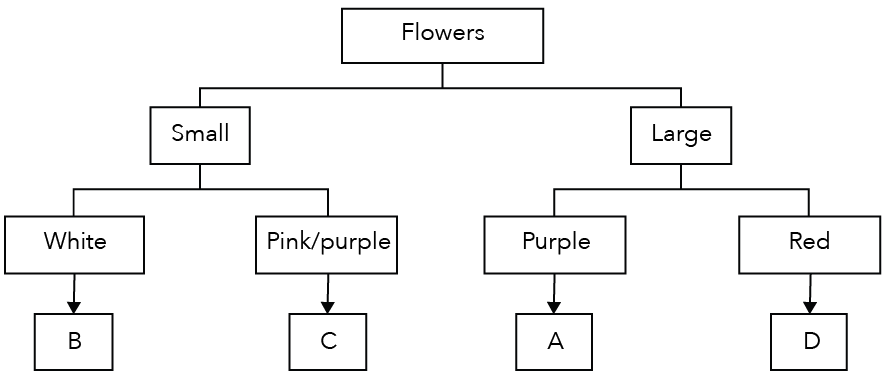
![]() Q65 (Question Booklet – Page 52, MCQ): SCGS/2013/P6/SA2/Q16
Q65 (Question Booklet – Page 52, MCQ): SCGS/2013/P6/SA2/Q16
Question Update: There has been a printing error in the MCQ options:
(1) B only
(2) A and C only
(3) B and D only
(4) C and D only
Electricity Practice Booklet – Errata
MCQ Question Booklet Update
![]() Q7 (Question Booklet – Page 7, MCQ): ACS/2013/P6/SA2/Q5
Q7 (Question Booklet – Page 7, MCQ): ACS/2013/P6/SA2/Q5
Corrected Option (2): Bulb Y will be brighter than bulb X.
![]() Q28 (Question Booklet – Page 28, MCQ): MGS/2013/P5/SA2/Q29
Q28 (Question Booklet – Page 28, MCQ): MGS/2013/P5/SA2/Q29
Corrected: In which of the circuits P, Q and R will the bulb light up?
![]() Q30 (Question Booklet – Page 30, MCQ): NYPSSC/2014/P5/SA2/Q23
Q30 (Question Booklet – Page 30, MCQ): NYPSSC/2014/P5/SA2/Q23
Typographical Error: NYPS/2014/P5/SA2/Q23
![]() Q36 (Question Booklet – Page 36, MCQ): RSS/2016/P5/SA2/Q15
Q36 (Question Booklet – Page 36, MCQ): RSS/2016/P5/SA2/Q15
Corrected: When the switch is closed, the light bulb lights up.
![]() Q44 (Question Booklet – Page 43, MCQ): RGPS/2016/P5/SA2/Q22
Q44 (Question Booklet – Page 43, MCQ): RGPS/2016/P5/SA2/Q22
Corrected Question: Option (4) is now S1 only
![]() Q55 (Question Booklet – Page 53, MCQ): NYPS/2013/P5/SA2/Q11
Q55 (Question Booklet – Page 53, MCQ): NYPS/2013/P5/SA2/Q11
Diagram Error: Wire was not properly connected at L2. Please take note of this amended diagram:
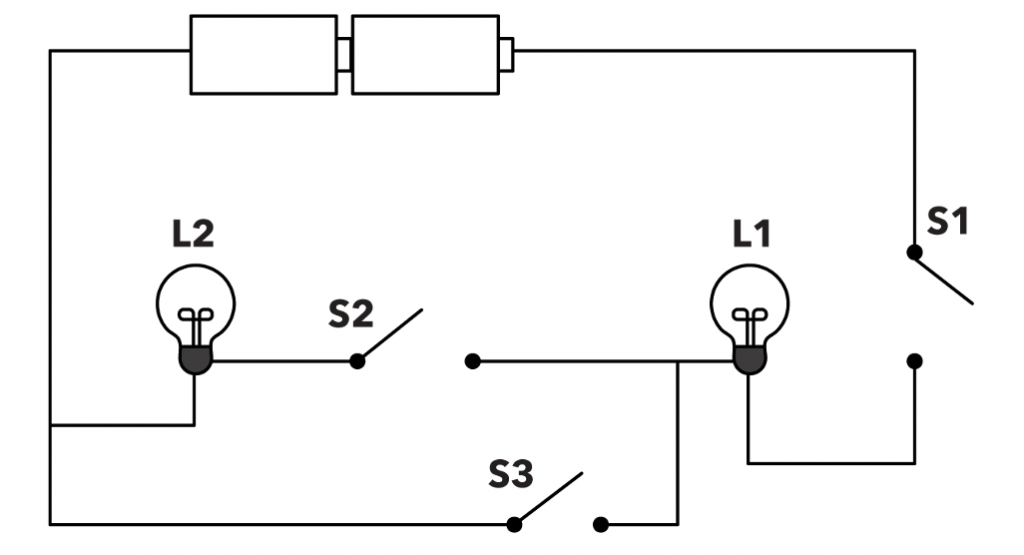
![]() Q62 (Question Booklet – Page 59, MCQ): RGPS/2015/P6/SA1/Q21
Q62 (Question Booklet – Page 59, MCQ): RGPS/2015/P6/SA1/Q21
Corrected Question: The diagram below shows how four bulbs, A, B, C and D…
![]() Q66 (Question Booklet – Page 62, MCQ): ROSYTH/2013/P5/SA1/Q26
Q66 (Question Booklet – Page 62, MCQ): ROSYTH/2013/P5/SA1/Q26
Corrected Option (2): A lit up but B did not.
OEQ Question Booklet Update
![]() Q2c (Question Booklet – Page 4, OEQ): BLGPS/2013/P5/SA1/Q40
Q2c (Question Booklet – Page 4, OEQ): BLGPS/2013/P5/SA1/Q40
Diagram Error: The graph for ‘Z’ was not drawn. Please use this amended diagram:
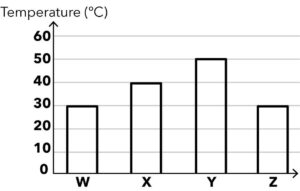
![]() Q17 (Question Booklet – Page 24, OEQ): CHS/2015/P6/SA1/Q42
Q17 (Question Booklet – Page 24, OEQ): CHS/2015/P6/SA1/Q42
Diagram error: Inaccurate line thickness in diagram
Please use this amended diagram:

![]() Q21 (Question Booklet – Page 28, OEQ): RSS/2014/P6/SA2/Q40
Q21 (Question Booklet – Page 28, OEQ): RSS/2014/P6/SA2/Q40
Updated table headers for experiment results (from left to right):
No. of batteries
Brightness of bulb in set-up A (unit)
Temperature of liquid X after 20 minutes (ºC)
Brightness of bulb in set-up B (unit)
Temperature of liquid Y after 20 minutes (ºC)
![]() Q22 (Question Booklet – Page 30, OEQ): CBS/2019/P6/SA2/Q39
Q22 (Question Booklet – Page 30, OEQ): CBS/2019/P6/SA2/Q39
Amended diagram for Experiment 1:

OEQ Answer Booklet Update
![]() Q1bi (Question Booklet – Page 2, OEQ): MSHS/2012/P6/SA2/Q32
Q1bi (Question Booklet – Page 2, OEQ): MSHS/2012/P6/SA2/Q32
Answer Diagram Error: x-axis is erroneously labelled as “Number of batteries”
Refer to amended diagram:

![]() Q5c (Question Booklet – Page 7, OEQ): ACSC/2014/P6/SA2/Q41
Q5c (Question Booklet – Page 7, OEQ): ACSC/2014/P6/SA2/Q41
Updated Answer: The bulbs in Circuit B will light up brighter than the bulbs in Circuit A.
OR
Step 1: The bulbs in Circuit B are arranged in parallel. If one bulb fuses, Step 2: there would still be a closed circuit with the other bulbs. Step 3: Thus, electric current would still flow through the other bulbs, Step 4: allowing the other bulbs to remain lit.
Errata Affecting Copies Before 31 Dec 2019
MCQ Question Booklet Update
![]() Q8 (Question Booklet – Page 8, MCQ): NYPS/2014/P5/SA2/Q24
Q8 (Question Booklet – Page 8, MCQ): NYPS/2014/P5/SA2/Q24
Question Update: There has been a printing error in the diagram’s labels. It should read Circuit A, B, C, D.
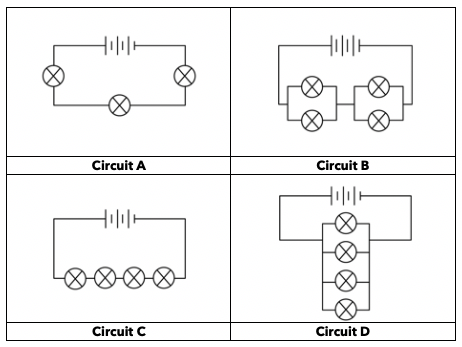
![]() Q15 (Question Booklet – Page 15, MCQ): NHPS/2017/P6/SA2/Q22
Q15 (Question Booklet – Page 15, MCQ): NHPS/2017/P6/SA2/Q22
Question Update: There has been a printing error in the position of the battery in Circuit A. The diagram below is accurate:
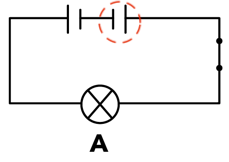
![]() Q21 (Question Booklet – Page 28, OEQ): RSS/2014/P6/SA2/Q40(b)(i)
Q21 (Question Booklet – Page 28, OEQ): RSS/2014/P6/SA2/Q40(b)(i)
Question Update: The question for Q21(b)(i) may be omitted from your copy:
Explain clearly how this set-up enables the camera to take a photograph of the snow leopard when it steps on P. [1.5]
OEQ Question Booklet Update
![]() Q29 (Question Booklet – Page 38, MCQ): SNGS/2016/P5/SA1/Q38(b)(i)
Q29 (Question Booklet – Page 38, MCQ): SNGS/2016/P5/SA1/Q38(b)(i)
Question Update: There has been a printing error – the label ‘C’ in (b)(i) may be omitted from the diagram.

Answer Booklet Update
![]() Q27 (Answer Booklet – Page 11, OEQ): ROSYTH/2013/P5/SA2/Q41
Q27 (Answer Booklet – Page 11, OEQ): ROSYTH/2013/P5/SA2/Q41
Answer Update: The answer field for Circuit B may be omitted from your question booklet.
Here’s the corresponding answer:
The bulbs in Circuit B are arranged in parallel.
Step 1: When bulb Y in Circuit B is fused,
Step 2: there is still a closed circuit with bulbs X and Z.
Step 3: This allows electric current to still flow through bulbs X and Z,
Step 4: allowing both of them to still light up.
Errata Affecting Copies Before 9 Feb 2021
OEQ Answer Booklet Update
![]() Q1bi (Question Booklet – Page 1, OEQ): MSHS/2012/P6/SA2/Q32
Q1bi (Question Booklet – Page 1, OEQ): MSHS/2012/P6/SA2/Q32
Original diagram was mistakenly drawn as a line graph. It should be a bar graph.
Please use this amended diagram:

![]() Q5c (Answer Booklet – Page 4): ACSC/2014/P6/SA2/Q41
Q5c (Answer Booklet – Page 4): ACSC/2014/P6/SA2/Q41
Updated Answer: The bulbs in Circuit B will light up brighter than the bulbs in Circuit A.
![]() Q19a (Question Booklet – Page 26, OEQ): HKPS/2013/P6/SA1/Q38
Q19a (Question Booklet – Page 26, OEQ): HKPS/2013/P6/SA1/Q38
Updated Answer:
Object X: Object X is a conductor of electricity
Object Y: Object Y is an insulator of electricity
![]() Q26a (Question Booklet – Page 34, OEQ): BGPS/2013/P5/SA1/Q32
Q26a (Question Booklet – Page 34, OEQ): BGPS/2013/P5/SA1/Q32
Diagram error in answer key: Indicated area was bolded wrongly.
Please use this amended diagram:
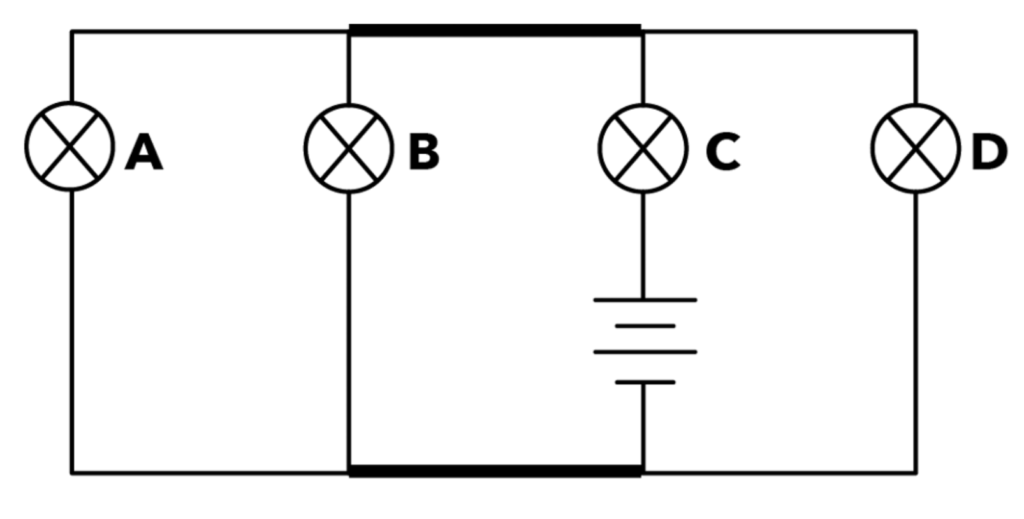
![]() Q28c (Question Booklet – Page 36, OEQ): ACSJ/2015/P5/SA2/Q36
Q28c (Question Booklet – Page 36, OEQ): ACSJ/2015/P5/SA2/Q36
Additional alternative answer:

Energy Practice Booklet – Errata
MCQ Question Booklet Update
![]() Q20 (Question Booklet – Page 18, MCQ): XSPS/2014/P6/SA2/Q4
Q20 (Question Booklet – Page 18, MCQ): XSPS/2014/P6/SA2/Q4
Please amend the label in the diagram as “Straw to direct steam“
OEQ Answer Booklet Update
![]() Q1a (Question Booklet – Page 1, OEQ): RVPS/2012/P6/SA1/Q44
Q1a (Question Booklet – Page 1, OEQ): RVPS/2012/P6/SA1/Q44
Answer Update: Include the additional parts in bold for a more complete answer:
The gravitational potential energy of metal ball A is converted to kinetic energy as it rolls down the ramp. Ball A lands on the wooden plank, pushing the left end of the wooden plank down. The kinetic energy of ball A is then transferred to the wooden plank, which is then converted to sound energy when the right end of the wooden plank moves upwards to hit the gong.
Alternative Answer Accepted:
The heavy metal ball A will roll down the ramp and push the left end of the wooden plank down. Thus, the right end of the wooden plank will move up and hit the gong, causing the gong to sound.
![]() Q6c (Question Booklet – Page 7, OEQ): CHS/2015/P6/SA2/Q40
Q6c (Question Booklet – Page 7, OEQ): CHS/2015/P6/SA2/Q40
Answer Update Q6c: State the factor: Since ball S was released from a lower height from the ground, Use energy conversion: it possessed less gravitational potential energy, which was converted to less kinetic energy. When ball S hit marble X, less kinetic energy of ball S was transferred to marble X, and was then converted back to less gravitational potential energy of marble X. Thus, marble X rolled up to a lower height on the ramp and was unable to hit the bell.
![]() Q10c (Question Booklet – Page 12, OEQ): NYPS/2017/P6/SA2/Q35
Q10c (Question Booklet – Page 12, OEQ): NYPS/2017/P6/SA2/Q35
Answer Update Q10c: Observation 2: All of the kinetic energy of the cube had been converted to heat and sound energy. Thus, the metal cube no longer possessed kinetic energy and came to a stop at Point C.
![]() Q19b (Question Booklet – Page 12, OEQ): NYPS/2017/P6/SA2/Q35
Q19b (Question Booklet – Page 12, OEQ): NYPS/2017/P6/SA2/Q35
Answer Update 19b: Using the same type of plastic cards and rubber bands ensures that the mass of the cards and the stiffness of the rubber bands are kept the same and would not affect the maximum height reached by the toy. Thus, there would only be one changed variable, which is the number of rubber bands used that would affect the results of the experiment.
Errata Affecting Copies Before 31 Dec 2019
MCQ Question Booklet Update
![]() Q35 (Question Booklet – Page 32, MCQ): SLPS/2014/P6/SA1/Q25
Q35 (Question Booklet – Page 32, MCQ): SLPS/2014/P6/SA1/Q25
Question Update: There may be in printing error in the MCQ options on your copy:
(1) A and C only
(2) B and D only
(3) C and D only
(4) A, B and C only
The answer is (3) C and D only.
Answer Booklet Update
![]() Q33 (Answer Booklet – Q1, MCQ): PHPPS/2016/P6/SA2/Q27
Q33 (Answer Booklet – Q1, MCQ): PHPPS/2016/P6/SA2/Q27
Answer Update: The answer is (1) Load.
Forces Practice Booklet – Errata
MCQ Question Booklet Update
![]() Q41 (Question Booklet – Page 34, MCQ): PCPS/2012/P6/SA1/Q4
Q41 (Question Booklet – Page 34, MCQ): PCPS/2012/P6/SA1/Q4
Question Update: Peter damped clamped a magnet as shown below.
MCQ Answer Booklet Update
![]() Q46 (Question Booklet – Page 40, MCQ): ROSYTH/2015/P6/SA2/Q23
Q46 (Question Booklet – Page 40, MCQ): ROSYTH/2015/P6/SA2/Q23
Answer Update: The answer is 1.
![]() Q51 (Question Booklet – Page 44, MCQ): RGPS/2012/P6/SA2/Q26
Q51 (Question Booklet – Page 44, MCQ): RGPS/2012/P6/SA2/Q26
Answer Update: The answer is 1.
![]() Q56 (Question Booklet – Page 48, MCQ): NHPS/2015/P6/CA1/Q14
Q56 (Question Booklet – Page 48, MCQ): NHPS/2015/P6/CA1/Q14
Answer Update: The answer is 4.
OEQ Answer Booklet Update
![]() Q6 (Question Booklet – Page 6, OEQ): HPPS/2015/P6/SA2/Q43
Q6 (Question Booklet – Page 6, OEQ): HPPS/2015/P6/SA2/Q43
Answer Update: Throw some fish off the boat to reduce the amount of gravitational force acting on the boat.
Errata Affecting Copies Before 31 Dec 2019
Answer Booklet Update
![]() Q15a (Answer Booklet – Page 5, OEQ): NHPS/2016/P6/CA1/Q36
Q15a (Answer Booklet – Page 5, OEQ): NHPS/2016/P6/CA1/Q36
Answer Update: The studs that stick out of the tyres make the surface of the tyres rougher, which increase the amount of friction between the tyres and the mud paths. This prevents the mountain bike from slipping when travelling on the mud paths.
Web of Life Practice Booklet – Errata
MCQ Question Booklet Update
![]() Q3 (Question Booklet – Page 2, MCQ): SCGS/2015/P6/SA1/Q14
Q3 (Question Booklet – Page 2, MCQ): SCGS/2015/P6/SA1/Q14
Question has been adapted for clarity: Susan has 3 papaya trees…
![]() Q14 (Question Booklet – Page 11, MCQ): NHPS/2016/P6/SA1/Q3
Q14 (Question Booklet – Page 11, MCQ): NHPS/2016/P6/SA1/Q3
Error in the last table entry: Dragonfly nymph
MCQ Answer Booklet Update
![]() Q52 (Question Booklet – Page 41, MCQ): RLPS/2012/P6/SA1/Q1
Q52 (Question Booklet – Page 41, MCQ): RLPS/2012/P6/SA1/Q1
Answer Update: The answer is 1.
Errata Affecting Copies Before 31 Dec 2019
MCQ Question Booklet Update
![]() Q5 (Question Booklet – Page 4, MCQ): SNGS/2017/P6/SA1/Q13
Q5 (Question Booklet – Page 4, MCQ): SNGS/2017/P6/SA1/Q13
Question Update: The four MCQ options are:
(1) A and B only
(2) A and D only
(3) B and C only
(4) C and D only (instead of D and D only)
![]() Q7 (Question Booklet – Page 5, MCQ): LHPS/2014/P6/SA1/Q9
Q7 (Question Booklet – Page 5, MCQ): LHPS/2014/P6/SA1/Q9
Question Update: The area for Habitat Y should read as 50m2 instead of 50km2.
![]() Q38 (Question Booklet – Page 32, MCQ): MBS/2014/P6/SA2/Q12
Q38 (Question Booklet – Page 32, MCQ): MBS/2014/P6/SA2/Q12
Question Update: If Option 3’s diagram is identical as Option 4’s diagram, please change it Option 4’s diagram to:
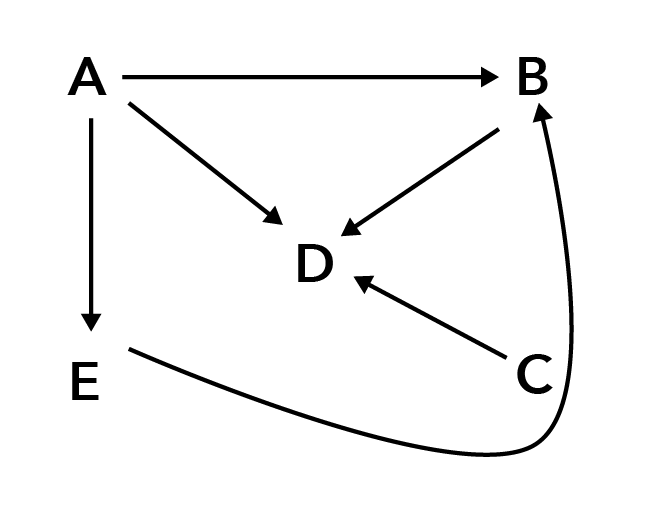
Answer Booklet Update
![]() Q42 (Answer Booklet – Page 1, MCQ): PCPS/2012/P6/SA1/Q24
Q42 (Answer Booklet – Page 1, MCQ): PCPS/2012/P6/SA1/Q24
Answer Update: There may be a typo on your answer booklet. The correct answer is Option 2.
![]() Q25 (Answer Booklet – Page 8, OEQ): CBS/2014/P6/SA2/Q33(b)
Q25 (Answer Booklet – Page 8, OEQ): CBS/2014/P6/SA2/Q33(b)
Answer Update:
Benefit 1: B (not X) breaks down dead matter into simpler substances, which are returned to the soil as nutrients, acting as fertilisers for the plants.
Benefit 2: B (not X) releases carbon dioxide during decomposition which is taken in by plants for photosynthesis to make food.
Adaptations Practice Booklet – Errata
MCQ Question Booklet Update
![]() Q3 (Question Booklet – Page 3, MCQ): NYPS/2012/P6/SA2/Q12
Q3 (Question Booklet – Page 3, MCQ): NYPS/2012/P6/SA2/Q12
Please refer to amended diagram:
![]() Q35 (Question Booklet – Page 30, MCQ): NYPS/2017/P6/SA2/Q2
Q35 (Question Booklet – Page 30, MCQ): NYPS/2017/P6/SA2/Q2
Corrected Question: 50 ml of water from each lake was placed in two separate glass beakers.
Diagram Error: Original diagram has no spacing between ’50’ and ‘ml’. Please take note of this amended diagram:
![]() Q46 (Question Booklet – Page 38, MCQ): NHPS/2015/P6/SA1/Q6
Q46 (Question Booklet – Page 38, MCQ): NHPS/2015/P6/SA1/Q6
Corrected Question: He prepared 3 similar set-ups like the one shown below and poured 50 ml of water onto each soil sample.
Corrected Question: He recorded the time taken for 30 ml of water to be collected in each measuring cylinder for the 3 types of soil.
OEQ Question Booklet Update
![]() Q8b (Question Booklet – Page 11, OEQ): MGS/2015/P6/SA1/Q37
Q8b (Question Booklet – Page 11, OEQ): MGS/2015/P6/SA1/Q37
Corrected Question: The picture below shows a diver and an Organism Y.
Errata Affecting Copies Before 31 Dec 2019
OEQ Question Booklet Update
![]() Q9 (Question Booklet – Page 12, OEQ): The original source should read MGS/2015/P6/SA2/Q36.
Q9 (Question Booklet – Page 12, OEQ): The original source should read MGS/2015/P6/SA2/Q36.
Question Update
Answer Booklet Update
![]() Q1 (Answer Booklet – Page 1, MCQ): RVPS/2012/P6/SA1/Q15
Q1 (Answer Booklet – Page 1, MCQ): RVPS/2012/P6/SA1/Q15
Answer Update: There may be a printing error in the answer booklet. The answer should be (3).
Man’s Impact on the Environment Practice Booklet – Errata
No errata found at this point! 🙂